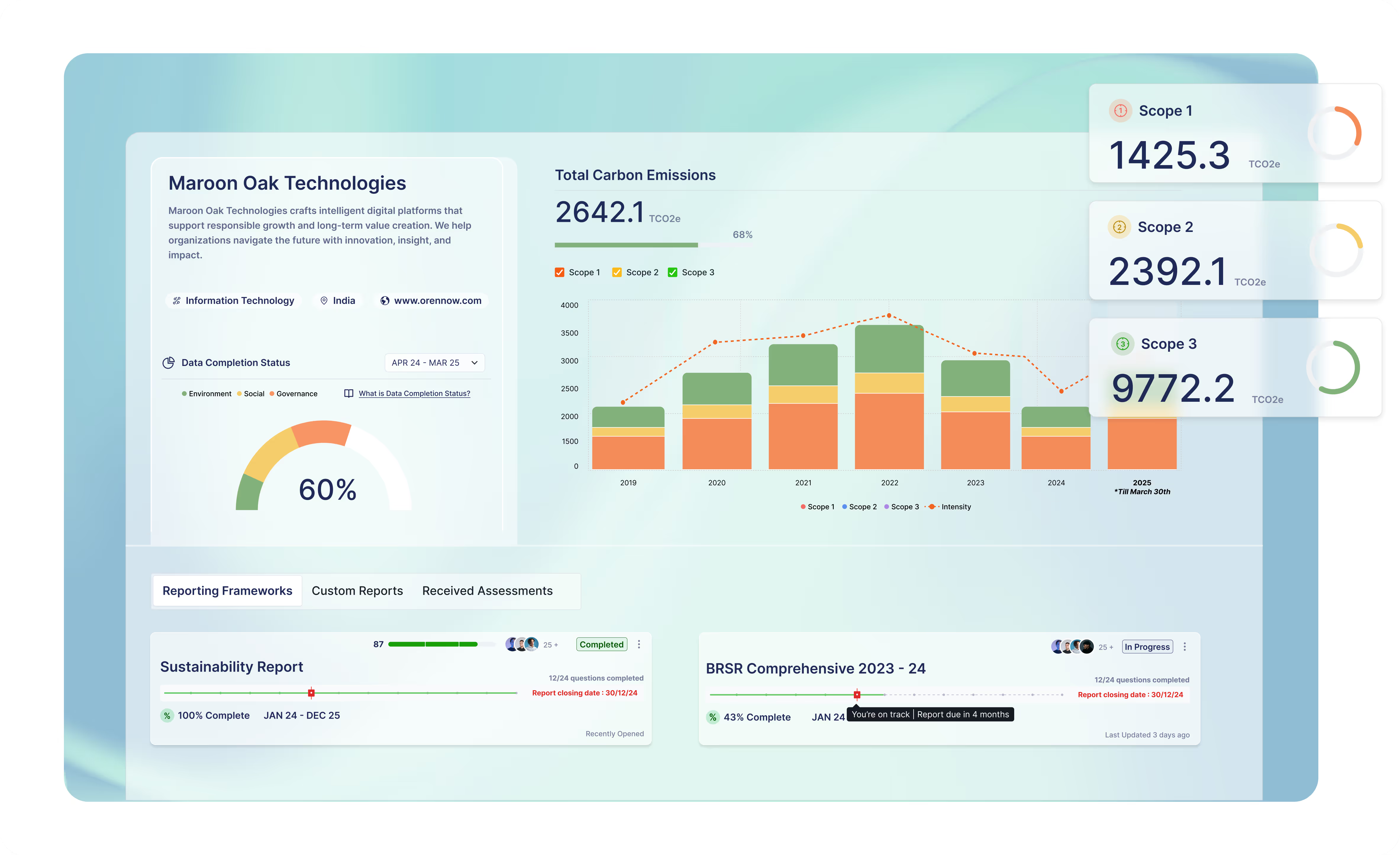Best Practices For Creating An Effective ESG Committee

What is an ESG Committee?
An ESG committee is organised to have an oversight of the environment, social and governance related matters across the company and ensure that the company has mechanisms in place to manage and mitigate risks and capture opportunities.
Although it is up to the company’s discretion on the organisational structure of the ESG committee, most companies have one independent non - executive director of the company, other members of the committee may be appointed as the Group CEO with the approval of the Board. The Group HSE (Health, Safety and Environment) and Sustainability Head shall be permanent invitees to the committee meetings.
Understanding the Role of an ESG-focussed Committee
The key role of an ESG-focused committee at the board is to ensure that the company is moving forward on its sustainability commitments. This committee also has to ensure the right amount of budget is allocated towards the committed sustainability goals and KPIs of the company.
The ESG committee is also responsible for ensuring that ESG is not treated as a tick-in-the-box exercise but is truly integrated into the operations and day-to-day implementation of business strategy.
The ESG committee should set the tone and reinforce the culture of sustainability within the company. It should also guide towards building a bridge between the company's business strategy and sustainability strategy. This committee has to keep a keen eye on the climate-related risks and opportunities of the company and should ensure that all operations, procurement, and product development are done in alignment with that.
The ESG Committee should also oversee communications with internal and external stakeholders, including employees, investors, customers, suppliers, and shareholders, regarding the company's position and approach on key ESG matters.

Why is an ESG committee required?
An ESG committee is required to keep the entire organisation, the sustainability department and other departments responsible for implementing ESG aligned with the company’s ESG strategy and goals.
The ESG committee should meet on a quarterly basis to track the progress on the ESG goals and KPIs committed for that time period. It should also support the sustainability department get buy-in and alignment with other departments and also get approvals on the budget.
ESG Board Committee Framework
There is no right time to create an ESG committee. This committee can be created as soon as the company publishes its first sustainability report or sets sustainability goals in place. The ESG committee is responsible for communicating to the board or the steering committee progress on their roles and responsibilities on a quarterly basis.
The ESG committee should ideally have the key stakeholders within an organization who are responsible for ESG integration and taking the ESG agenda forward. This could be the Chief Sustainability Officer, the Chief Employee Health and Safety Officer, or the Chief Financial Officer. This committee reports directly to the Board of Directors of the company.
With the ESG Committee, companies also need an ESG Charter. This ESG Charter should contain information on the following:
- Who is part of the ESG Committee
- Their roles and responsibilities
- The company's ESG strategy
- The company’s committed ESG goals and KPIs.
This should also ensure that they are providing regular training to the board members and the ESG committee so that they can stay up-to-date with the latest regulations, frameworks, and requirements across the organization. At Oren, we recommend the ESG committee regularly conduct a peer benchmarking exercise with global and local peers so that they themselves and the board are on top of what is happening in the industry in general.
Common Approach for Creating an ESG Committee
There is no one size fits all when it comes to ESG governance. A small, but growing percentage of boards have created dedicated ESG committees, while others have designated oversight to either the full board or to one or more existing board committees such as audit, risk and nominations.
Here are some structural considerations to set up an ESG committee:
- The ESG Committee should have well documented ESG Committee Charter capturing the following:
- Purpose and objective
- Roles and responsibilities
- Membership and composition
- Meetings and Quorum
- Reporting Frequency
- Authority
- The ESG Committee should have board-level oversight to drive board priority
- The ESG Committee should have diversity of skills and experience covering the three pillars of environment, social and governance. It should ideally also have members that have a background in environmental science, human resources, operations, compliance, finance and supply chain management.
- Having independent directors in the committee helps reduce potential conflicts of interest.
- The ESG Committee should have a clear mandate and reporting process.
- The ESG Committee should also coordinate with other committees such as the audit committee or compensation committee to ensure that they are not working in silos and are building on top of each other.
Some questions that can be asked while setting up an ESG committee:
- How to ensure all ESG risks are identified and addressed in corporate strategy?
- Does the committee have the appropriate diversity in terms of skillsets, experience and knowledge to oversee sustainability matters?
- How to set up a cadence to ensure effective communication among the board, committees and management?
- How do we ensure we conduct timely capacity building of the board, top management and key employees on sustainability topics?
- Who are employees with the depth of sustainability knowledge, not only from a disclosure perspective but also from a subject matter expertise perspective for our company?
- Are there any ways in which we can include other committees such as audit, risk and compliance to make the ESG committee more effective?
.webp)
5 Important Areas to Help the Board Focus on What Really Matters
Just like ESG strategy, every company's ESG committee is built according to their ESG maturity. Here are some areas that will help the board focus on what really matters:
- ESG committee charter: This charter helps inform the committee and the Board on the key roles and responsibilities of everyone involved. It also acts as a compass to keep the committee aligned on their goals and the timelines of the goals.
- Treat ESG Committee Like Other Board Committees: For proper integration of ESG across the company, it is essential to treat the ESG committee as any other board committee.
- Phases of creating an ESG team: The ESG Committee can evolve over time. As a company implements more initiatives and hence expands its ESG team, the committee can also change its shape, form, and responsibilities accordingly.
- Be Deliberate With ESG Board Composition: Not every company needs a climate change expert or a human rights lawyer to be part of their ESG committee. These committees can be very simple and should include members who truly understand the company's operations and the feasibility of integration of ESG goals across the company's operations.
- Focus on Material Risks and Opportunities: The committee’s attention should be focused on material risks and opportunities, and the choice about what to share with the board should be guided by management’s understanding of materiality assessment.
Conclusion
A good indicator of an ESG committee is to ensure that the organization has a strong and identifiable corporate purpose that incorporates all stakeholder perspectives and expectations. Setting related ESG objectives should also be a complimentary exercise; the committee must help the management team focus on business performance while balancing competing stakeholder interests. There needs to be a strong reminder that ESG objectives which do not support long-term business growth and sustainability, may be the wrong objectives.
If you’re creating your ESG Committee, talk to Oren's sustainability experts for a free consultation for guidance on how to do it right.
Frequently Asked Questions
1. What is an example of good ESG?
Good ESG is about disclosures and action. Companies must implement initiatives to reduce their ESG impact such as reducing their emissions, managing water more efficiently, providing benefits to their employees and workers etc. And they must publish these initiatives and their quantified impact in a sustainability/ESG report. In India, companies can pick between a BRSR (Business Responsibility and Sustainability Report) or GRI (Global Reporting Initiative) reporting format to publish their ESG data.
2. What things are usually not discussed enough in ESG committees?
ESG committees should not only focus on disclosures but also discuss financial materiality and business integration of their ESG initiatives. ESG can be a technical topic so the sustainability teams should conduct capacity building workshops of the Board and top management to make sure they are an active participant in the strategy development and approval process.
3. How to create an ESG program?
To create a well thought out ESG program, companies should not blindly pick up a program that has been implemented by their competitors and apply it to their business. They should start by conducting a materiality assessment to determine the material topics relevant to their operations. Companies should also engage all stakeholders groups such as employees, customers, suppliers, Board of directors etc. to determine which material topics these groups prioritise. Companies can then collect data from all their operational locations and departments to create a sustainability report. Using a technology platform such as Oren Sustainability Hub can speed up the data collection and reporting process.
4. What are the requirements of ESG committee formation?
The ESG committee should include members that deeply understand ESG so conducting annual capacity building sessions can help in bringing that understanding and alignment. The specific structure can defer by company size, industry, and maturity. An ESG Committee Charter should be established capturing the purpose, roles and responsibilities, membership structure and authority etc.
5. Who handles ESG in a company?
ESG is typically handled by the Chief Sustainability Officer and their team. Some companies expand the responsibilities of their Chief Financial Officer or Head of Employee Health and Safety to include implementation and integration of ESG. We do recommend eventually having a dedicated leader for ESG since it requires technical sustainability know-how to do a thorough job of implementing sustainability initiatives that yield results and alignment with business strategy.
6. Who regulates ESG in India?
There are four key stakeholders that care about ESG in India. It is regulated by SEBI (Securities and Exchange Board of India) as it mandated ESG disclosures for the top 1000 listed companies in the form of BRSR (Business Responsibility and Sustainability Reporting). In addition to that, Investors, Customers (primarily in the base of B2B businesses) and Bankers want to look at a company’s ESG disclosures.
7. How many pillars are there in ESG?
There are three key pillars of ESG - Environment, Social and Governance. Environment covers how the company is impacting the physical environment through the emissions it does by burning fossil fuels, consuming electricity or through its value chain, consuming and recycling water, generating and managing waste etc. Social is concerned with its impact on their internal and external stakeholders such as employees, workers, suppliers etc. And Governance is concerned with how it operates in a transparent and ethical manner.
Latest Blog Posts
Dive into our blog for insights on making your organization more sustainable.
Sustainability Simplified
Wherever you are in your sustainability journey, we help you advance with confidence.
Schedule a Call



.avif)

